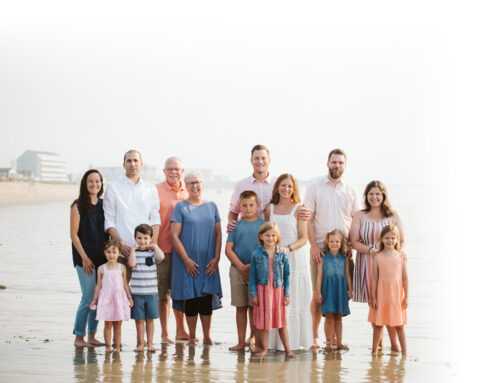EDS IN THEIR BLOOD
by Robert Mitchell
Bob Myers III, is better known in his family as “Bobby.”
 Bobby was just a teen when he climbed into a Salvation Army canteen and tagged along with his father, Bob Myers Jr. Together they would answer calls for help when natural and man–made disasters struck the community.
Bobby was just a teen when he climbed into a Salvation Army canteen and tagged along with his father, Bob Myers Jr. Together they would answer calls for help when natural and man–made disasters struck the community.
“I was always around the canteen,” Bobby says. “It was part of our family’s life. It was something I always had a passion for.”
Bob jokes that his son “took over the family business” by entering Emergency Disaster Services (EDS) work like his father.
“He grew up on a canteen. Over the years, he got up in the middle of the night and went on fire calls and things like that with me,” Bob said. “It was a natural progression. As he got a little older, he wanted to volunteer.”
Both father and son vividly remember answering the call on the morning of Sept. 11, 2001. In the aftermath of those terrorist attacks, they served in Shanksville, Pa., and Bob later at Ground Zero in Manhattan. They agree that EDS work has dramatically changed in the two decades since.
In ensuing years, such disasters as hurricanes, floods, earthquakes, and COVID–19 have occurred. Bobby served at most of them.
“We’re not without our disasters,” says Bobby, who became the territory’s EDS boss in 2019. “It used to be every two or three years, but now it seems like every year we have something we’re either dealing with directly in our own territory or in support of another territory.
“That’s part of the nature of what we do in emergency disaster services. People often forget about EDS until a disaster happens, but the reality is EDS is a year–round effort. We do local disasters 365 days a year throughout the territory, whether it be a house fire or a small flood or whatever the situation may be.”
A Different Approach
Bobby said the canteen ministry used to be the focus of EDS. Today, it is a part of EDS.
“It’s certainly still a significant part, but it’s one part of a much bigger operation that we serve under emergency management,” he said. “Now we really look at things as all–encompassing.”
Bob said EDS was a “stepchild program” when he first started, but that has all changed. He noted that since 9/11, The Salvation Army has made significant financial investments “in resources and equipment and things.”
“I was lucky if I had a canteen that actually ran well,” he said. “I went from having a couple of broken–down canteens and one moderately good one to rebuilding an entire fleet.
 “We had a mobile command center and a mobile supply center and all kinds of other cool toys in our toolbox. Those kinds of resources led us to provide support at a lot of other national emergencies around the country. The Army is positioned really well to be there and to be effective.”
“We had a mobile command center and a mobile supply center and all kinds of other cool toys in our toolbox. Those kinds of resources led us to provide support at a lot of other national emergencies around the country. The Army is positioned really well to be there and to be effective.”
Bobby said that before 9/11, EDS focused mostly on response and feeding support. While those remain significant components, The Salvation Army today offers a more comprehensive emergency management approach.
“We now have equal attention on the recovery side of things and the preparedness side of things,” he said. “Disaster recovery has become just as big a part of what we do. We look to help people’s, immediate and long–term needs.”
Training for Best Results
Training for Best Results
Bobby said The Salvation Army today has a robust national disaster training program, which developed after 9/11.
“We use trained volunteers year–round,” he said. “We’ve raised the level of expertise in the professional ranks and we’re trying to support the Army holistically.”
What separates The Salvation Army from its partners in the EDS world is its spiritual component.
“It’s not just the physical relief we provide, although that’s certainly important, but it’s also the emotional and spiritual support,” Bobby said. “It’s even more than just pastoral care. It starts there and moves into ‘disaster mental health’ with some of our experienced people trained at a higher level.”
Bobby said the spiritual side of EDS is a huge motivator for him.
“It’s those moments when the Lord opens doors to me in those difficult times that I find rewarding as an individual,” Bobby said. “The faith part is one of the most significant aspects. The Lord finds ways to assure me as a disaster worker that He’s using me in ways that I can’t always see.
“EDS has always been one of the core missions of The Salvation Army. It’s why we’re a unique faith–based organization and a church. We talk a lot in the Army about the ‘ministry of presence’ and I feel EDS is a big part of that. You don’t always have to use words to show Jesus.”
Springing into Action
Springing into Action
The fateful morning of Sept. 11, 2001, when everything changed for the Salvation Army’s EDS efforts, is never far from the mind of father or son.
Bob, who served as the Salvation Army’s EDS director in Pittsburgh, remembers driving into the office that morning after a long night on a fire call. He was listening to local radio personality and fellow Salvationist Fred Honsberger on 1020 KDKA–AM when the news broke. Bob raced into the office and made phone calls to the Greater New York Division and to Territorial Headquarters.
“I literally was engaged within the first five minutes of 9/11 and for the next two or three hours,” Bob said. “I was getting my staff all on board. I knew we were going to get busy because we operated a national supply program for EDS. I knew that we were already going to have to ramp up supply support from our division to the Greater New York Division, so that became our focus.”
One of Bob’s calls was to Bobby, who was sleeping that morning after working another overnight shift as a AAA dispatcher. His father told him he needed him in the office immediately.
A few hours later, Bob took a call from the county’s EDS director. There was a report of a missing plane over the Western Pennsylvania Division. The plane, United Airlines Flight 93, had also been hijacked by terrorists and eventually crashed in Shanksville, Pa. For the next 16 days, Bob and Bobby both served in Shanksville, while also supporting efforts at the Pentagon, which had been hit by another hijacked plane.
“I had a multifaceted response because we provided heavy supply support to the Pentagon and to Greater New York while responding to Shanksville,” Bob recalls. “We shipped in an entire truckload of supplies so that they had them the next morning at 8 a.m. These were uniforms, the food service products that were branded with our logo, and things like that.”
“That started an almost daily supply shipment. While in Shanksville, we did support functions for the Pentagon and even New Jersey where we shipped equipment.”
Fighting the Battle Together
Fighting the Battle Together
Bob was in Shanksville for 17 days before deploying to Ground Zero. His original assignment was to set up logistics, but he quickly became the operations chief for two weeks.
Early in 2002, with 9/11 still on the country’s mind, Bobby took the job as EDS director in Philadelphia for the Eastern Pennsylvania and Delaware Division. That same year, he served at Ground Zero in Manhattan at the conclusion of operations.
Both father and son would go on to serve together as EDS directors from 2002 until Bob retired in 2010.
Bob said, “It worked out great for me and for him because I had the western half of the state, and he had the eastern half. We were able to join forces regularly and work together for common goals. We got to see each other and go to statewide meetings all the time. It was nice to stay connected with him.”
Today, Bob is the executive director of Off The Floor Pittsburgh, a faith–based, non–profit furniture bank that provides donated furnishings to agencies that help people get their lives back together.
Bob said he misses EDS work. He calls it “the most exciting job in the world, if you do it right.” The year he left, the Western Pennsylvania Division’s personnel had answered 325 calls. The work was long and arduous. He admits, “I hit the wall, I burned out a few times, but I kept going.
“The work was exciting. Most people see it on the evening news, but I got to see it live and in person,” he said.
Some of Bob’s more memorable deployments were the Midwest floods of 1993, the Los Angeles earthquake of 1994, and Hurricane Katrina in 2005.
“My final big assignment was Katrina,” he said. “I didn’t really have any major deployment after Katrina, but that was a blast. I looked at it as a challenge and this is what I worked to do all the time. This is what I prepared myself for. My job was to be the ringmaster and keep the whole thing going.”
As the 20th anniversary of 9/11 looms, Bob said it’s always an emotional day for him as he recalls the events.
“I take time and pause and think back and reach out to some people who have become lifelong friends. We worked together there on that day at Ground Zero and supported colleagues at the other sites,” he said. “It’s always one of those solemn days. I think about it regularly.”
Bobby took part in the ceremonial closing of the 9/11 site and said he still has flashbacks all these years later.
“It’s one of those things that always sticks with me,” Bobby says. “I remember certain aspects of it from time to time and sometimes it will just pop in my mind or something will trigger a reminder, but certainly as I lean into that date every single year, it kind of rings true.
“It just kind of solidified, for me, a desire to help people who are in that greatest time of need.”




